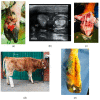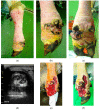Septic Tenosynovitis of the Digital Flexor Tendon Sheath in 83 Cattle
- PMID: 32751431
- PMCID: PMC7460132
- DOI: 10.3390/ani10081303
Septic Tenosynovitis of the Digital Flexor Tendon Sheath in 83 Cattle
Abstract
Septic tenosynovitis of the digital flexor tendon sheath (DFTS) is the second most prevalent infection of deeper structures of the distal limb in cattle, after septic arthritis of the distal interphalangeal (DIP) joint. Depending on the type of infection and the involvement of adjacent anatomical structures, various surgical techniques may be used for therapy: Incising the DFTS to resect one or both digital flexor tendons (RDFT), additional resection of the DIP joint (RDIP) or additional digital amputation (RAMP). Our goal was to describe clinical findings and outcome in cattle patients (euthanasia vs. treatment) and the success of surgical methods including improvement of locomotion and postoperative survival time (POST). Data of eighty-three cattle with a mean age of 4.3 years were reviewed in this retrospective study. Overall, 57.7% of tenosynovitis cases were in the lateral DFTS of a hind limb. Fifty-five cattle were treated surgically; the remaining 28 cattle were euthanized following diagnosis. The median cumulative POST was 17.3, 83.1, and 11.9 months for RDFT, RDIP, and RAMP, respectively. Fatal postoperative complications occurred in three cattle. We conclude that the applied methods were successful and allowed the animals to almost reach the average life expectancy of an Austrian dairy cow.
Keywords: cattle; digital flexor tendon sheath; postoperative survival time; tendon resection; tenosynovitis.
Conflict of interest statement
The authors declare no conflict of interest.
Figures



References
-
- Kofler J. Neue Möglichkeiten der Diagnostik der septischen Tendovaginitis der Fesselbeugesehnenscheide des Rindes mittels Sonographie – Therapie und Langzeitergebnisse. Dtsch. Tierärztl. Wschr. 1994;101:215–222. - PubMed
-
- Müller M., Gehringer S. Pathologie komplizierter Klauenerkrankungen. In: Fiedler A., Maierl J., Nuss K., editors. Erkrankungen der Klauen und Zehen des Rindes. 2nd ed. Thieme; Stuttgart: 2019. pp. 209–217.
LinkOut - more resources
Full Text Sources

